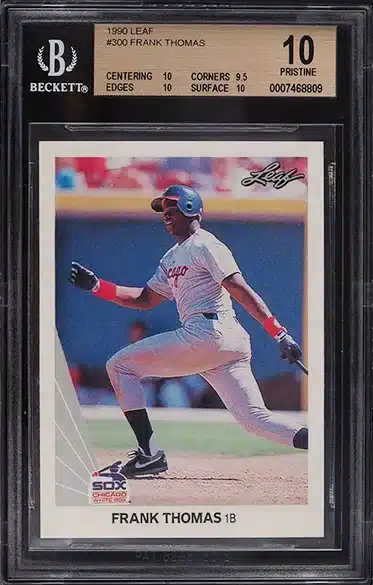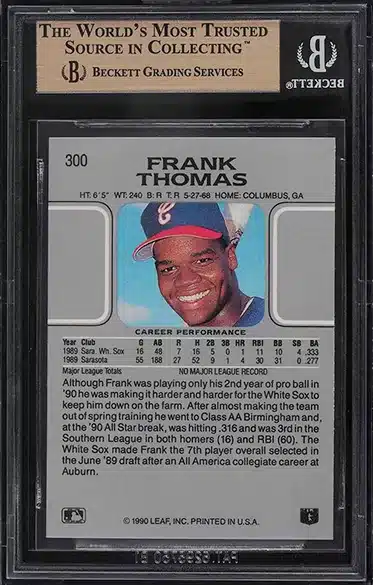Introduction
When collecting Frank Thomas rookie cards, you have a few options. In this list, I included some of his early inserts and other issues of Thomas that hold as much, if not more, value as his rookie card. If you want to see updated pricing, click the link to eBay. Remember, collect what you like and buy what you can afford.
1990 Leaf Frank Thomas RC #30
- Year: 1990
- Set: Leaf
- Player: Frank Thomas
- Card Number: #300
- Grade: BGS 10
- Sold Date: September 2023
- Auction House: eBay
- Price: $2,005
1990 Leaf printed a great-looking rookie card of Thomas. The action photo shows how easy he made it look to crush balls out of the park. His name is prominently displayed on the card in black ink over a white background. You can quickly identify the White Sox logo offset to the top left of his name. Collectors are always in the market for a Leaf Frank Thomas rookie, in BGS 10 pristine condition.
Population Report: 1990 Leaf Frank Thomas Rookie Card
When discussing the 1990s era of baseball cards, the term “over-printed, junk cards” is frequently bandied about. But not all highly printed cards from this decade fall into the ‘junk’ category. Case in point: the 1990 Leaf Frank Thomas rookie card.
Beckett, one of the foremost grading companies, has evaluated a whopping 6,254 of these Frank Thomas rookie cards. Of these, 38 reached the pinnacle of BGS 10 pristine condition, 1,069 achieved a grade of 9.5 gem mint, and 2,042 were designated as mint 9. When it comes to market value, BGS 9.5s currently trade around the $73 mark. Meanwhile, PSA 10s — a grade from another top-tier grading service — often fetch between $150 to $200. By this valuation, it’s clear that the real goldmine for investors lies in the scarce BGS 10 cards.
Investment Outlook on the 1990 Leaf Frank Thomas RC
The 1990 Leaf Frank Thomas rookie card holds its own in terms of desirability, with 2,994 copies having been graded as Gem-Mint 10. This number will inevitably rise as more collectors submit their cards for grading. But will an increase in population dilute its value? And what about those rare 38 BGS 10s? Will their numbers surge or remain exclusive? Only the future holds these answers.
Nonetheless, this card remains a definitive piece from Thomas’s early career. For those looking to invest, purchasing raw copies and submitting them for grading could be a shrewd move. Given the card’s white borders, achieving a Gem-Mint 10 grade might not be as elusive as one might think.
#16
1990 ProCards Glossy Birmingham Barons
Frank Thomas Rookie Card Minor League #1116
Recently sold for $450
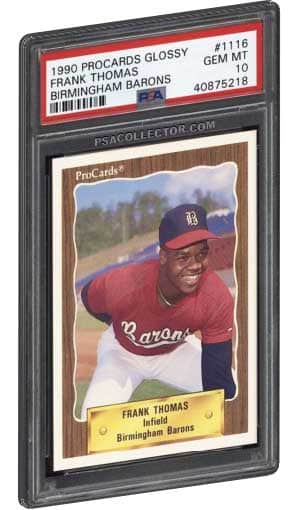
Are you looking to find a very elusive Frank Thomas Minor League card? Look for the 1990 ProCards Glossy copy.
This set combines CMC team sets with cards produced by ProCards and purchased by CMC. The ProCards were given a glossy facing and randomly inserted in wax packs along with CMC cards.
Gatorade Symbol
On the back of the card, you’ll notice the Gatorade symbol, which is why this card is often called “the Gatorade card.” You’ll also see the card number on the bottom right is missing. Those are the things to look for when hunting this card down.
Population Report
#1116 in the ProCards glossy set has 17 cards in the population report. With only two graded PSA gem mint 10, it’s safe to say this card is scarce in perfect condition. It should be higher up on the list, but it’s hard to rank without evidence of competing buyers. We have seen two sales so far, one at $106 and 1 at $59.
#14
1990 O-Pee-Chee
Frank Thomas Rookie Baseball Card #414 – PSA 10
Recently Sold for $731

Topps printed a set for Canada called O-Pee-Chee. The cards are identical except for the slightly brighter back, the O-Pee-Chee trademark, and the French copy underneath the English.
Population Report
With only 107 graded Gem-Mint 10 on the market, one would think these Thomas rookies would be a little more valuable. After all, the Chipper Jones O-Pee-Chee rookie cards sell for $335 on average.
I would keep my eye on the O-Pee-Chee cards. The front look precisely like the Topps, but the back has a very noticeable variation. I can see the value and collectability go up in the future for these Thomas rookies.
#8
1987 Baseball USA Pan-Am
Frank Thomas Rookie Card #36 – PSA 10
Recently Sold for $1,283
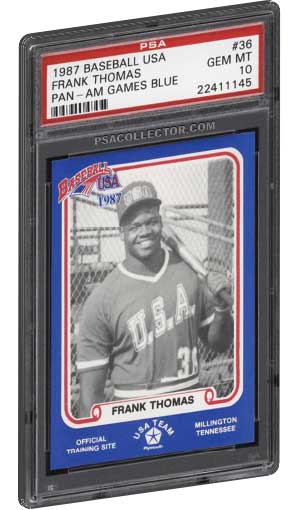
Issued in 1987 to introduce the USA baseball team playing in the Pan-Am games. Included in the series is the first and actual rookie card of Frank Thomas.
Like his Minor League cards, the USA team card is rather dull. A black and white portrait of Thomas holding the bat provides no sense of his baseball-crushing abilities. Although, the red, white, and blue borders surrounding him make it very patriotic.
Population Report
Two hundred nineteen cards have been found, submitted, and graded. 12 Gem-Mint 10’s are on the market or in the hands of collectors as of today. Making a Gem Mint copy very valuable. Finding un-graded cards on eBay can be pretty easy. Finding well centered, smooth bordered, and edges copies will prove quite tricky.
#6
1988 P&L Cape Cod League
Frank Thomas Rookie Card #126
Recently sold for $2,979
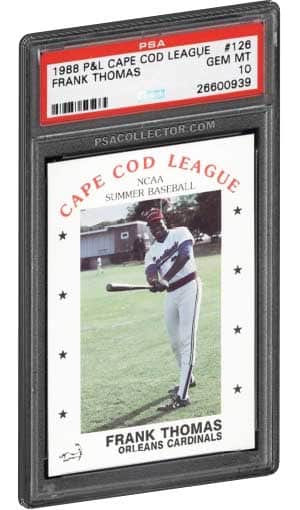
His Cape Cod Minor League card, is a great way to start the list. The one of Frank Thomas looking like he’s practicing his golf swing in someone’s backyard. The 1988 P and L Promotions Cape Code Prospects is the most common of the limited Frank Thomas Minor League cards. It’s an affordable card for those looking for something early and different.
Population Report
1,311 have been submitted and 307 were given gem mint 10. If you want a copy of one you can expect to pay roughly $2,000+.
#5
1990 Bowman Tiffany
Frank Thomas Rookie Card #320 – PSA 10
Recently Sold for $2,000
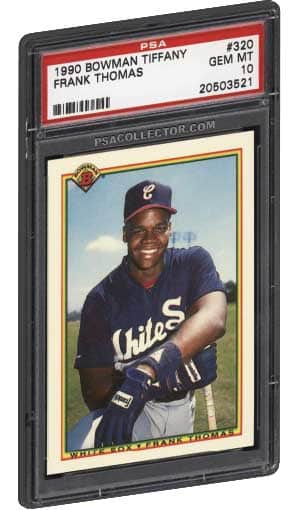
A must-have for any Frank Thomas rookie card collector is the Bowman Tiffany. The glossy front and smaller production make it both valuable and collectible. Set it next to the more affordable 1990 Bowman Gem-Mint 10 card you probably already have.
Population Report
The current value of a 1990 Bowman Tiffany Frank Thomas rookie card, in PSA 10 condition, is $2,000. However, a PSA 9 example is much cheaper selling for $200. The Bowman Tiffany is a great card to add to your collection and will hold its value for years to come.
#4
1990 Topps Tiffany
Frank Thomas Rookie Card #414 – PSA 10
Recently Sold for $2,091
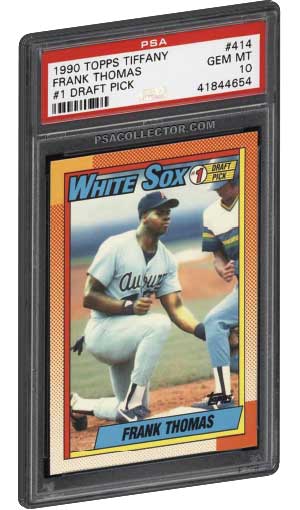
We can’t leave the Topps Tiffany card off the list; it would be an incomplete list. Topps Tiffany baseball cards provided collectors with a more premium option for many sets from the Junk Wax Era.
Between 1984 and 1991, Topps made a relatively limited number of factory sets with better production values. Secondary values of Topps Tiffany cards are much stronger than their regular Topps counterparts.
Population Report
Although the print run for the 1990 Topps Tiffany set is unknown, the 1989 set had 25,000 produced. Eight hundred thirty-three copies have been submitted to PSA, and 97 were in Gem-Mint 10 condition. Mint 9 copies have 400+ and growing. I feel the PSA 10 population will remain the same for years to come. This could prove to be an excellent investment card in Gem Mint condition.
#3
1987 Auburn Tigers
Frank Thomas Minor League Rookie Card – PSA 10
Recently Sold for $7,400
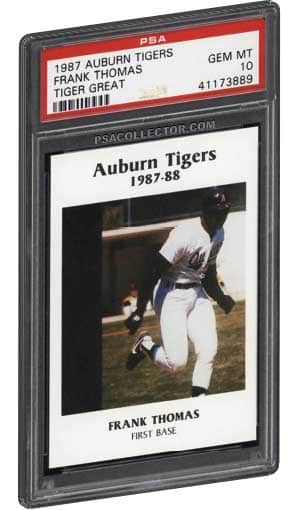
The first known Frank Thomas card is a relatively rare one. Printed for Auburn University, the set focuses on greats who attended the school. The set has only two collectible players, Bo Jackson (football and baseball) and Frank Thomas. Its plain design isn’t what makes this card so desired. The notoriety for being Frank Thomas’s first card fuels the value.
This rare piece of history will only go up in value. Do a simple search on eBay, and you’ll get a glimpse of its scarcity. The PSA population report announces the rarity as well.
Population Report
PSA graded 71 Auburn Tigers Frank Thomas rookie cards. Sixteen of them were in Gem-Mint 10 condition. With only 23% of known copies in perfect condition, expect the value to increase. If you cross paths with a raw un-graded copy, jump on it!
#1
1990 Topps No Name on Front
Frank Thomas Rookie Card #414
Last sold for $24,244
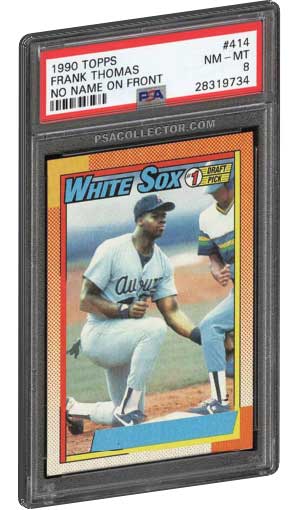
Well, here it is. The Holy Grail of Frank Thomas cards is his 1990 Topps Rookie card without his name printed on the front, better known as the No Name on Front.
These are extremely rare and valuable. How many of these cards exist is unknown. Since it comes from the Junk Wax Era, when sports cards were significantly overprinted, it is doubtful to find one in a pack today. They are said to be found in the New England wax packs only printed in a specific area of the Country.
How did this happen?
There is speculation on how this error card came into existence, which is unsolved today. Some theories are the ink dried out on the roller, and there was a piece of cut stock cardboard over the paper. You can read more about the topic on the thread here: 1990 Topps Frank Thoma NNOF.
Population Report
Ever since 1994, when the uproar about this Thomas rookie started, only 202 have been submitted to PSA for grading. Of those 202, only one came out to be in Gem-Mint 10 condition, just staggering statistics. Imagine what it would go for today at auction? My guess would be well over $100,000.
The bulk of the cards submitted was in NM-MT 8 condition with a population of 92. Regardless of the condition, this card is very valuable and highly collectible.
Frank Thomas
Frank Thomas was one of the most exhilarating players to come out of the MLB in the 90s. The former first-baseman and power-hitter played primarily for the Chicago White Sox, and what a job he did! Also known as “The Big Hurt,” this six-five, 250-plus pound behemoth was murderous at the plate. So much that when this slugger entered the batter’s box, pitchers were likely shaking in their little booties. And, why shouldn’t they have been?
Awards
Awarded back-to-back American League (AL) MVP Awards in 93’ and 94’, Frank Thomas was a force to be reckoned with in the MLB. The Big Hurt was incredibly determined to put up huge numbers throughout his career, but he also had the talent to do it. Early in his career, Thomas spoke to the Chicago Tribune about his burning desire to influence the game, saying, “I want to make a dent in the game.” After playing the game for 18 years, it’s no stretch of the imagination to say that The Big Hurt got his wish. Inducted into The Hall of Fame (HoF) in 2014, the slugger made his mark on Major League Baseball.
Still not convinced? No worries.
Besides, what does the National Baseball Hall of Fame know anyways? I mean, it’s not like it’s comprised of countless former players, club managers, team execs, notable umps, and baseball pioneers dedicated to “Preserving History, Honoring Excellence, Connecting Generations” regarding the game. Whiskey-Tango-Foxtrot?
In any event, let’s look at the life and career of baseball great Frank Thomas. Hopefully, you’ll understand what the folks in Cooperstown thought when they immortalized this living legend in Baseball’s HOF.
Early Life
On Monday, May 27, 1968, an unrealized baseball legend entered this world. Frank Edward Thomas was born in Columbus, GA, as one of five children to Frank and Charlie May Thomas. Of course, despite coming from a more prominent family, Frank didn’t exactly have it rough. Thomas admitted to being somewhat pampered by his parents and old brothers and sisters. Family and friends called Thomas by the handle “Big Baby.”
However, regardless of his cushy upbringing, Thomas was chiseled out of stone when it came to sports. Even though his parents didn’t force sports upon him as a young man, Thomas excelled in athletics at a young age. He claimed, “When I was a kid, probably around 12, I already knew I wanted to be a player.”
Like many greats, Frank Thomas was a born athlete.
The Big Hurt grew up playing baseball, football, and basketball, making the 12-year-old Pop Warner football league at age 9. His excellence in sports got him a scholarship to The Brookstone School, a prestigious high school in Columbus, where he led his team to a state championship. In his senior year, Thomas had a .440 BA for the baseball team, earned an All-State title as a tight end with the football team, and played on the basketball team.
In other words, he was your classic “triple-threat.”
Thomas wanted to get drafted right out of high school. However, when passed over in the 1986 amateur draft, he took a football scholarship to Auburn University. In addition to his football obligations, he also made an impression on the Tigers’ baseball team. Then-coach, Hal Baird, told Sports Illustrated that the team “loved him.”
After crushing it in college ball, 1987 was a year that had Thomas playing for the US Pan American Team. He made it to the Pan American Games twice during his collegiate career but returned to Auburn to fulfill his football scholarship. Ultimately, he switched tracks and focused primarily on baseball. This decision to change directions led him into running for the US Olympic Team of 1988. Eventually, Thomas got his break as a seventh-round draft pick by the White Sox in 1989.
Professional Career
If Frank Thomas didn’t coin the idiom “come out swinging,” then I don’t know who did. (Fact: This phrase originated in boxing and has nothing to do with Frank Thomas.) Either way, The Big Hurt lived up to his unique nickname early on in his career. In other words, he was decimating pitchers from the beginning.
After taking down the Minor League’s Player of the Year Award, his first entire season with the White Sox in 1991 was remembered. Thomas put up a solid batting average (BA) of .318, 32 Home Runs (HR), 102 Runs (R), 109 Runs Batted In (RBI), 138 Intentional Walks (IBB). Let alone; he was getting on base almost half the times he was in the batter’s box with an On-base Percentage (OBP) of .453.
1992 was a solid year for Frank Thomas
Following suit, in 1992, Thomas earned his first MVP Award and led the league in Doubles (2B), IBB’s, and OBP with the White Sox. At this time, Thomas had a .317 BA, 41 HR, and 128 RBI for the American League West title-winning team. Even crazier is that Thomas reaped a unanimous MVP decision with all 28 first-place votes.
Believe it or not!
1993 was an even better year for this lumber-swinging titan. His BA hopped up to a stellar .353 while he continued knocking them deep with 38 homers. Thomas swung 101 RBI and scored 106 runs in just 113 games. Of course, I’m sure he could have put up more significant numbers. But, in case you forgot, there was a STRIKE that year!
Notwithstanding the 1994-95 Baseball Strike, Thomas continued knocking the snot out of baseballs. As a result, the Hall of Famer won a 1997 batting title with a .347 BA. Meanwhile, he also upheld a record of 100 RBI, 100 IBB, 20 HR, and .300 BA for seven straight seasons! To compare this stat to former players, Babe Ruth (12) and Lou Gehrig (9) were the only players with more same-state seasons. And Ted Williams and Barry Bonds share this number with Thomas at 8.
Frank Thomas had one more season with 100 RBI, 100 IBB, 20 HR, and .300 BA in 2000.
After sustaining severe injuries in the early 2000s and missed half of the games in 2001, 2004, and 2005, despite not helping his team for over 34 games in 2005, the White Sox won the World Series that year. However, the Sox realized his waning ability and bought out the remainder of his contract with the team. He left their all-time leader in runs, doubles, homers, total bases, and walks.
After leaving Chicago, The Big Hurt took up residence in Oakland, followed by Toronto. First, in 2006, Thomas went with the A’s and swatted 39 home runs and had 114 RBI. Shortly after his stint in Oakland, Thomas moved to Toronto after signing an $18 million deal with the Blue Jays for the next two years.
Frank’s MLB career winds down due to a disagreement.
As it turned out, the Blue Jays let Thomas go early in 2008 because of “disagreements about the line-up.” To put it differently, The Big Hurt was ticked off; he had been taken out of the line-up. So, it was back to Oakland for 55 more games with the A’s, a leg injury, and the end of his career.
The End of a Legacy
Coupled with injuries putting a halt to his 2008 season, Thomas sat the 2009 season out entirely. In February of 2010, Thomas retired from the game of baseball. After 19 seasons playing in the MLB, Thomas spoke about his decision saying he was “at peace” with it. At the end of his career, his lifetime stats are as follows: 521 HR (#18 all-time), 1,704 RBI (#22 all-time), .301 BA, .419 OBP, and 1,667 walks (#10 all-time).
Back to back MVP
Of course, these remarkable numbers go along with four Silver Slugger Awards, nine finishes in the AL MVP’s Top Ten, back-to-back MVPs, and five All-Star game appearances. I mean, come on! A five-time All-Star who bats a .301 average, and gets on base 41.9% of the time? What’s there not to celebrate? Not to mention, The Big Hurt is in the “500 Club,” tying Ted Williams and Willie McCovey for the 18th spot on the list of all-time home runs.
All Things Considered
All things considered, you don’t get the name “The Big Hurt,” if you’re an average player. Legend to have knocked the guts right out of a ball, Thomas’ dangerous swatting ability alongside his large stature earned him a nickname for the ages. Frank “The Big Hurt” Thomas will be forever recognized as one of Chicago’s most lethal players with the lumber.
From a young age, Matt dove deep into sports card valuation, turning to esteemed price guides like Beckett and Tuff Stuff. Eventually he extended to Pokémon, Magic: The Gathering, and Yu-Gi-Oh!. With a vision to sustain and nurture the hobby he loved, Matt established the ‘Graded Card Investor’ YouTube channel and website. He aims to foster a healthy community and offer invaluable insights to those entering the world of sports cards and TCGs. His depth of understanding, from the card market’s 2020 pinnacle to its 1990s valleys, is consistently fortified by meticulous research.

